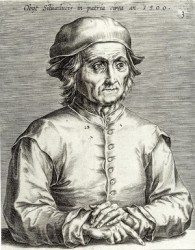
Romein 1971
“Jeroen Bosch. Meester der duisternis” (Annie Romein) 1971
[in: Jan and Annie Romein, Erflaters van onze beschaving. Nederlandse gestalten uit zes eeuwen. Em. Querido’s Uitgeverij, Amsterdam, 1971 (9th, revised and expanded edition), pp. 59-78 (1st edition: 1938-40)]
[Also mentioned in Gibson 1983: 168 (H64)]
It is suggested that there is a distant affinity between Bosch’s Carrying of the Cross scenes and those of the painters of the Cologne school. Bosch was not the big loner as has been suggested by some authors. We have to study his work in the light of book illumination, gothic sculpture, literature, dramatic art and the urban festive customs of his age. He shows less affinity with contemporary painting: Bosch is more common (but not in the modern sense), less reserved and formal, but more extravagant and sharper, less stylish than his painting contemporaries.
In the fifteenth century middle-class rationalism began to affect the indivisibility of the holy and the diabolical. In his work Bosch integrated the increasing ethical-symbolical and rational-didactic character that can also be found in the literature of his age. This ‘trend’ also appealed to Philip II.
Bosch was a ‘seer’, in the most direct meaning of the word: a master in the art of observation, this most typical contribution of the Dutch people to European civilization.
[explicit]